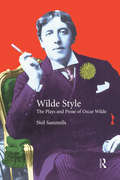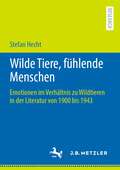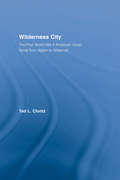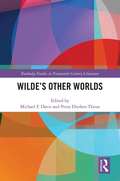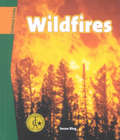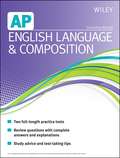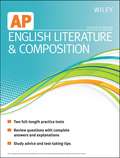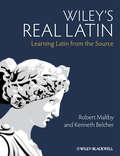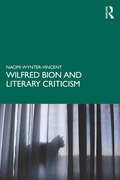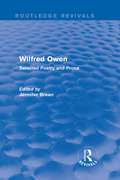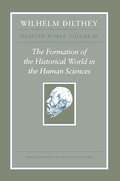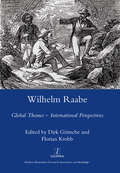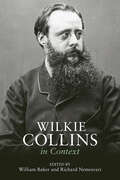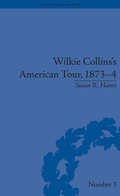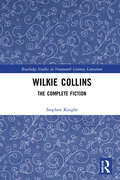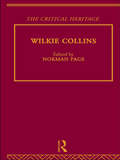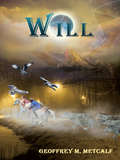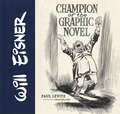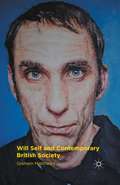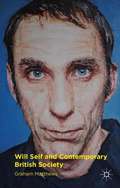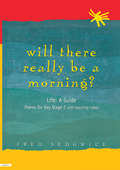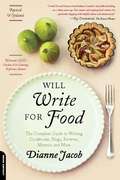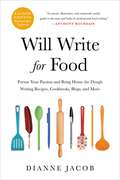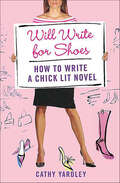- Table View
- List View
Wilde Style: The Plays and Prose of Oscar Wilde (Studies In Eighteenth and Nineteenth Century Literature Series)
by Neil SammellsThis new study of the major prose and plays of Oscar Wilde argues that his dominant aesthetic category is not art but style. It is this major emphasis on style and attitude which helps mark Wilde so graphically as our contemporary. Beginning with a survey of current Wilde criticism, the book demonstrates the way his own critical essays anticipate much contemporary cultural theory and inform his own practice as a writer.
Wilde Tiere, fühlende Menschen: Emotionen im Verhältnis zu Wildtieren in der Literatur von 1900 bis 1943
by Stefan HechtAnhand von Werken von Ludwig Ganghofer, Hermann Löns, Felix Salten, Waldemar Bonsels und Otto Alscher, die zwischen 1900 und 1943 erschienen sind und in denen die Jagd zentral ist, widmet sich dieser Band der Rolle und der Darstellung von Emotionen in den Beziehungen zwischen Menschen und Wildtieren. Dabei wird die Überschneidung neuerer Emotionsforschung mit den Cultural and Literary Animal Studies erprobt. Es wird gezeigt, dass Wildtiere zu Beginn des 20. Jahrhunderts im Zeichen von Wandel standen. Manche Texte spiegeln eine Abschwächung des Anthropozentrismus. Wildtiere werden verstärkt in ihrer Bedrohung sowie als individuelle Persönlichkeiten mit eigenen Ausdrucksmitteln dargestellt. Ihre subtile Gefühlswelt stellt die Exklusivität des Menschlichen in Frage. Hingegen mischt sich Ambivalenz unter die Emotionen von Jägern und Jagd. Hervorgehoben wird diese Tendenz durch das Aufzeigen narrativer Perspektivverschiebung zu den Tieren, der Poetisierung von Emotionen sowie materiell-semiotischer Mensch-Tier-Verknüpfungen. Über den historischen Rahmen der Textauswahl hinaus sensibilisiert dieses Buch für eine weitläufigere Reflexion über die Prekarität von Wildtieren unter besonderer Berücksichtigung der ethischen Dimension von Emotionen.
Wilderness City: The Post-War American Urban Novel from Nelson Algren to John Edger Wideman (Literary Criticism and Cultural Theory)
by Ted ClontzThe books seeks to examine changes in the U.S.--literary, aesthetic, and social--as represented in novels set in an environment where the gamut of ethnicities and their often differing views of literature and culture that make up the U.S. are more generally found, using the theories and concepts of Mikhail Bakhtin, particularly his concept of the chronotope, or spacetime.
Wilde’s Other Worlds (Routledge Studies in Nineteenth Century Literature)
by Petra Dierkes-Thrun Michael F. DavisTaking its cue from Baudelaire’s important essay "The Painter of Modern Life," in which Baudelaire imagines the modern artist as a "man of the world," this collection of essays presents Oscar Wilde as a "man of the world" who eschewed provincial concerns, cultural conventions, and narrow national interests in favor of the wider world and other worlds—both real and imaginary, geographical and historical, physical and intellectual—which provided alternative sites for exploration and experience, often including alternative gender expression or sexual alterity. Wilde had an unlimited curiosity and a cosmopolitan spirit of inquiry that traveled widely across borders, ranging freely over space and time. He entered easily and wholly into other countries, other cultures, other national literatures, other periods, other mythologies, other religions, other disciplines, and other modes of representation, and was able to fully inhabit and navigate them, quickly apprehending the conventions by which they operate. The fourteen essays in this volume offer fresh critical-theoretical and historical perspectives not just on key connections and aspects of Wilde’s oeuvre itself, but on the development of Wilde’s remarkable worldliness in dialogue with many other worlds: contemporary developments in art, science and culture, as well as with other national literatures and cultures. Perhaps as a direct result of this cosmopolitan spirit, Wilde and Wilde’s works have been taken up across the globe, as the essays on Wilde’s reception in India, Japan and Hollywood illustrate. Many of the essays gathered here are based on groundbreaking archival research, including some never-seen-before illustrations. Together, they have the potential to open up important new comparative, transnational, and historical perspectives on Wilde that can shape and sharpen our future understanding of his work and impact.
Wildfires (Discovery Links: Set A)
by Susan RingIn the forest, walls of flames, some 100 feet high, tear across the land, burning acres and acres of land. How can this wildfire be stopped? Find out how smoke jumpers and hot shot crews battle these fires, learn what causes them, and discover how fires are a natural part of some ecosystems.
Wiley AP English Language and Composition
by WoodsScore your highest on exam day Relax. The fact that you're even considering taking the AP English Language & Composition exam means you're smart, hard-working, and ambitious. All you need is to get up to speed on the exam's topics and themes and take a couple of practice tests to get comfortable with its question formats and time limits. That's where Wiley AP English Language & Composition comes in. This user-friendly and completely reliable guide helps you get the most out of any AP English class and reviews all of the topics emphasized on the test. It also provides two full-length practice exams, complete with detailed answer explanations and scoring guides. This powerful prep guide helps you practice and perfect all of the skills you need to get your best possible score. And, as a special bonus, you'll also get a handy primer to help you prepare for the test-taking experience. A detailed overview of the test Subject reviews covering all test topics Practice questions Sample free-response questions with advice for crafting critical essays Strategies and solid test-taking advice Two full-length practice tests with detailed explanations and walk-throughs Supplemented with handy lists of test-taking tips and more, Wiley AP English Language & Composition helps you make exam day a very good day, indeed.
Wiley AP English Literature and Composition
by Geraldine WoodsScore your highest on exam dayRelax. The fact that you're even considering taking the AP English Literature & Composition exam means you're smart, hard-working, and ambitious. All you need is to get up to speed on the exam's topics and themes and take a couple of practice tests to get comfortable with its question formats and time limits. That's where Wiley AP English Literature & Composition comes in.This user-friendly and completely reliable guide helps you get the most out of any AP English class and reviews all of the topics emphasized on the test. It also provides two full-length practice exams, complete with detailed answer explanations and scoring guides. This powerful prep guide helps you practice and perfect all of the skills you need to get your best possible score. And, as a special bonus, you'll also get a handy primer to help you prepare for the test-taking experience.A detailed overview of the testSubject reviews covering all test topicsPractice questions Sample free-response questions with advice for crafting critical essaysStrategies and solid test-taking adviceTwo full-length practice tests with detailed explanations and walk-throughsSupplemented with handy lists of test-taking tips and more, Wiley AP English Literature & Composition helps you make exam day a very good day, indeed.
Wiley's Real Latin
by Robert Maltby Kenneth BelcherThis innovative guide to the Latin language, written for a new generation of students, deploys examples and translation exercises taken exclusively from the Classical Latin canon.Translation exercises use real Latin from a variety of sources, including political speeches, letters, history, poetry, and plays, and from a range of authors, including Julius Caesar, Cicero, Virgil, Catullus, Ovid, and Plautus, among othersOffers a variety of engaging, informative pedagogical features to help students practice and contextualize lessons in the main narrativePrepares students for immersion in the great works of Classical Latin literatureA companion website provides additional exercises and drills for students and teachers
Wilfred Bion and Literary Criticism
by Naomi Wynter-VincentWilfred Bion and Literary Criticism introduces the work of the British psychoanalyst, Wilfred Bion (1897–1979), and the immense potential of his ideas for thinking about literature, creative process, and creative writing. There is now renewed interest in Bion’s work following the publication of his Complete Works but the complexities of his theory and his distinctive style can be forbidding. Less well-known than Freud or Lacan, the work of Wilfred Bion nevertheless offers new insights for psychoanalytic literary criticism and creative writing. For newer readers of his work, this book offers an engaging introduction to several of Bion’s key ideas, including his theory of thinking (the ‘thought without a thinker’), the container/contained relationship, alpha-function; alpha-elements, beta-elements, and bizarre objects; K and -K; the Grid, O, and the caesura. It also offers a way in to Bion’s astonishing and challenging experimental work, A Memoir of the Future, and explores the impact of his devastating personal experiences as an officer during the First World War. Each chapter of Wilfred Bion and Literary Criticism draws on one or more specific aspects of Bion’s theory in relation to creative texts by Sigmund Freud, Stevie Smith, B.S. Johnson, Mary Butts, Jean Rhys, Nicholas Royle, J.G. Ballard, and Wilfred Bion himself. The first full-length study to explore the potential of Bion’s ideas for literary criticism, Wilfred Bion and Literary Criticism introduces his complex and extensive work for a new audience in an accessible and engaging way, and will be of great interest to scholars of creative writing, literary criticism, and psychoanalysis.
Wilfred Owen: Selected Poetry and Prose (Routledge Revivals)
by Jennifer BreenFirst published in 1988, this annotated selection of Wilfred Owen’s poetry and prose provides a comprehensive one-volume text of his best work. As well as the war poems, it includes illuminating early pieces such as ‘Impressionist’ and ‘Little Claus and Big Claus’, which illustrate Owen’s early command of satire and narrative. The prose includes Owen’s well-known draft Preface and a wide range of his letters, showing the devotion he felt for his mother, his poetic development after meeting Siegfried Sassoon, and, above all, his war experiences. With a detailed introduction and helpful commentary, this timely reissue will be of particular value to A-Level and undergraduate students with an interest in the work of Wilfred Owen, his contemporaries, and the context of the First World War.
Wilhelm Dilthey: The Formation of the Historical World in the Human Sciences
by Wilhelm DiltheyThis volume provides Dilthey's most mature and best formulation of his Critique of Historical Reason. It begins with three "Studies Toward the Foundation of the Human Sciences," in which Dilthey refashions Husserlian concepts to describe the basic structures of consciousness relevant to historical understanding.The volume next presents the major 1910 work The Formation of the Historical World in the Human Sciences. Here Dilthey considers the degree to which carriers of history--individuals, cultures, institutions, and communities--can be articulated as productive systems capable of generating value and meaning and of realizing purposes. Hegel's idea of objective spirit is reconceived in a more empirical form to designate the medium of commonality in which historical beings are immersed. Any universal claims about history need to be framed within the specific productive systems analyzed by the various human sciences. Dilthey's drafts for the Continuation of the Formation contain extensive discussions of the categories most important for our knowledge of historical life: meaning, value, purpose, time, and development. He also examines the contributions of autobiography to historical understanding and of biography to scientific history.The finest summary of Dilthey's views on hermeneutics can be found in "The Understanding of Other Persons and Their Manifestations of Life." Here, Dilthey differentiates understanding relative to three kinds of manifestations of life. After giving his analysis of elementary understanding, he examines the role of induction in higher understanding and interpretation, and the relevance of transposition and re-experiencing for grasping individuality.
Wilhelm Raabe: Global Themes - International Perspectives
by Dirk Göttsche Florian KrobbWilhelm Raabe (1831-1910) is one of the major figures of 19th-century German Realist writing, acknowledged as an innovator both stylistically and thematically. But until now there has been little concentration on the international and postcolonial dimensions of Raabe's work - his literary critique of colonialism, his engagement with modernization and globalization, his involvement in 19th century German discourses about America, Africa and Asia, and the links between international and national issues in his writing. In Raabe International, contributions from many eminent critics address Raabe both as a writer on world affairs and as a subject himself for translation and comment outside of Germany.
Wilkie Collins in Context (Literature in Context)
by William Baker Richard NemesvariThis collection of essays by international scholars celebrates the 200th anniversary of Wilkie Collins's birth by exploring his unconventional life alongside his works, critical responses to his writings and their afterlife, and the literary and cultural contexts which shaped his fiction. Topics discussed include gender, science and medicine, music, law, race and empire, media adaptations, neo-Victorianism, disability, and ethics. Along with an analysis of his novels, the essays included also recognize the importance of his short stories, journalism, and contributions to Victorian theatre, most notably illuminating the strong connections between sensation fiction and melodrama, as well as exploring his influence on film and TV. Engaging with yet also delving far beyond the famous novels, this volume promotes awareness of Collins' remarkable and diverse writerly achievements and paints a vivid portrait of an author whose fluctuating reputation among contemporary critics stands in stark contrast to his immense and still-enduring popularity.
Wilkie Collins's American Tour, 1873-4 (The History of the Book #3)
by Susan R HanesIn the autumn of 1873, Wilkie Collins followed the example of fellow literary celebrities Dickens and Thackeray, and began a six-month reading tour of America. This book places this tour within the American lyceum movement of the later nineteenth century.
Wilkie Collins: The Complete Fiction (Routledge Studies in Nineteenth Century Literature)
by Stephen KnightThis book provides the first comprehensive overview of the complete works of Wilkie Collins’s. Examining his vast array of novels and short stories, this volume includes analysis of the social, historical, and political commentary Collins offered within his works, illuminating Collins as more than a successful crime and sensation author, or the fortunate recipient of Dicken’s grand patronage, but as a hard-thinking and lively-writing part of the rich mid-Victorian literary scene. Overall, Collins is seen as a master of narratives which deal with social and personal issues that were much debated in his fifty-year authorial period. Close attention is paid to the events, themes, and characterization in his fiction, revealing his analytic vigor and the literary power of that period and context. Delivering fresh insight into the variety and richness of Collins’ themes and arguments, this volume provides a key source of information and analysis on all Collins’ fiction.
Wilkie Collins: The Critical Heritage (Critical Heritage Ser.)
by Norman PageFirst published in 1995. Routledge is an imprint of Taylor & Francis, an informa company.
Will
by Geoffrey M. MetcalfWill is a 9-year-old boy with cerebral palsy. He is a very bright and sensitive child but requires a walker to get around. We discover him playing game cube in his bedroom as the strange face of Elverness appears on the TV screen. Elverness tells Will he needs to go to Acquinistere to help defeat a great evil. Will is diffident and reluctant but agrees to try to help. Will is suddenly transported to a strange place with a yellow sky and blue sun. He discovers he can walk and run unassisted. He and Elverness are joined by two talking horses that transport them to a medieval type city. Yes, the story is derivative and very consistent with the genre. However, despite the ‘journey/quest’ elements, it is much more a ‘life lessons’ story.
Will Eisner: Champion of the Graphic Novel
by Paul LevitzA celebration of the life of the acclaimed comic book storyteller through his work as well as interviews with fellow creators.Will Eisner (1917–2005) is universally considered the master of comics storytelling, best known for The Spirit, his iconic newspaper comic strip, and A Contract With God, the first significant graphic novel. This seminal work from 1978 ushered in a new era of personal stories in comics form that touched every adult topic from mortality to religion and sexuality, forever changing the way writers and artists approached comics storytelling. Noted historian Paul Levitz celebrates Eisner by showcasing his most famous work alongside unpublished and rare materials from the family archives. Also included are original interviews with creators such as Jules Feiffer, Art Spiegelman, Scott McCloud, Jeff Smith, Denis Kitchen, and Neil Gaiman—all of whom knew Eisner and were inspired by his work to create their own graphic novels for a new generation of readers.NOTE: The cover is a high-quality photographic reproduction of Eisner's original art. The design intentionally reveals tape and other stray markings that are part of the artist's process and reflect the age of the artifact that was photographed.“Eisner was not only ahead of his times; the present times are still catching up to him,” —John Updike“What Will did was and is timeless,” —Neil Gaiman“Will Eisner is, and remains, one of my precious idols,” —Frank Miller"He was the greatest,” —Harvey Kurtzman“Will Eisner is a national treasure,” —Jules Feiffer“Will Eisner is the heart and mind of American comics,” —Scott McCloud“Eisner is the single person most responsible for giving comics its brains,” —Alan Moore“Eisner was unique in feeling from the start that comic books were not necessarily this despised, bastard, crappy, lowbrow kind of art form, and that there was a potential for real art,” —Michael Chabon
Will Self and Contemporary British Society
by G. MatthewsThis stimulating and comprehensive study of Will Self's work spans his entire career and offers insightful readings of all his fictional and non-fictional work up to and including his Booker prize nominated novel Umbrella.
Will Self and Contemporary British Society
by Graham MatthewsThis stimulating and comprehensive study of Will Self's work spans his entire career and offers insightful readings of all his fictional and non-fictional work up to and including his Booker prize nominated novel Umbrella.
Will There Really Be a Morning?: Life: A Guide - Poems for Key Stage 2 with Teaching Notes
by Fred SedgwickThis is a book about the power of poetry to speak about the central themes of what it is to be a human being. The first part is an anthology of specially selected poems. The second part provides detailed notes for teachers on how to use these poems in the classroom. The poems in the book are about morality: how we get on, or don't get on, with each other; how we feel when we are alone; the destruction of the world we live in; childhood; celebration; fear; death; and mystery. Sharing these poems helps us to understand ourselves, and to express ourselves. The poems are selected to help to break down the barriers between curriculum subjects, and to be especially useful for religious education and personal, social and moral education. There is a mixture of the classic, the traditional and the new here, but all of the selected poems show the true power of poetry to express feelings about things that matter.
Will Write for Food
by Dianne JacobThe success of Julie & Julia highlights the newest trend in food writing: blogging. Noted journalist and food-writing instructor Dianne Jacob has revised her award-winning book to include a chapter covering all the how-to’s of food blogging as well as updated resources and new information on working in other wildly popular genres, namely cookbooks and food memoirs. Incredibly timely, this new edition of Will Write for Food is the must-have for every foodie who wants to put pen to page--or hands to keyboard.
Will Write for Food: The Complete Guide to Writing Cookbooks, Blogs, Memoir, Recipes, and More
by Dianne JacobFor more than 15 years, writing coach, editor, and blogger Dianne Jacob has taught food lovers how to take their passion from the plate to the page. Now, Jacob has revised and updated her award-winning guide. Whether you've been writing for years or are just starting out, Will Write for Food offers what you need to know to succeed and thrive, including: - A new chapter dedicated to making an income from food writing - Updated information about self-publishing and cookbook production - Tips on creating and sustaining an irresistible blog with gorgeous photos - The keys to successful freelancing and reviewing - Advice from award-winning writers, editors, and agents - Engaging, fun writing exercises to get the juices flowing
Will Write for Food: The Complete Guide to Writing Cookbooks, Blogs, Reviews, Memoir, and More
by Dianne JacobThe success of Julie & Julia highlights the newest trend in food writing: blogging. Noted journalist and food-writing instructor Dianne Jacob has revised her award-winning book to include a chapter covering all the how-to's of food blogging as well as updated resources and new information on working in other wildly popular genres, namely cookbooks and food memoirs. Incredibly timely, this new edition of Will Write for Food is the must-have for every foodie who wants to put pen to page-or hands to keyboard.
Will Write for Shoes: How to Write a Chick Lit Novel
by Cathy Yardley* What is Chick Lit exactly?* How do I write a Chick Lit novel?* What are the steps I need to take to get published?Once dismissed as a fad by the popular press and literary community, the women's fiction genre called Chick Lit is now one of the hottest growing markets for new writers. In Will Write for Shoes, veteran Chick Lit and romance author Cathy Yardley addresses the common questions (and misconceptions) about the genre.Based on years of teaching about commercial women's fiction, this definitive guide provides invaluable tips and step-by-step methods for writing and selling a successful Chick Lit novel. Features include:* The history of Chick Lit* A blueprint for writing a Chick Lit novel* New trends in the genre* Tips and tools for breaking into the market* FAQs and miscellaneaA directory of agents and publishers who acquire Chick Lit, sample submission materials, and online resources make this fun and comprehensive manual a must-have for all women who want to write a Chick Lit novel.
